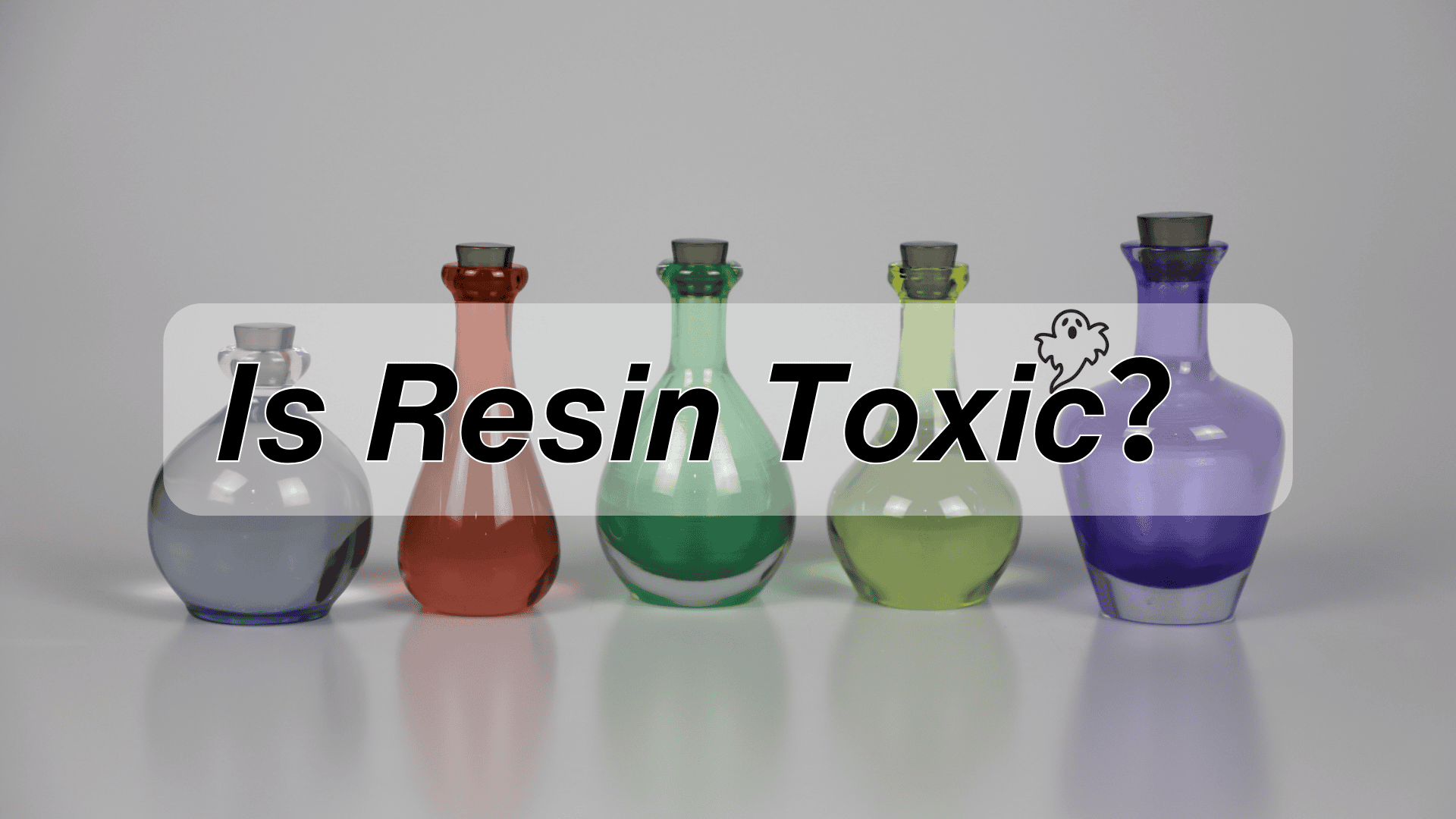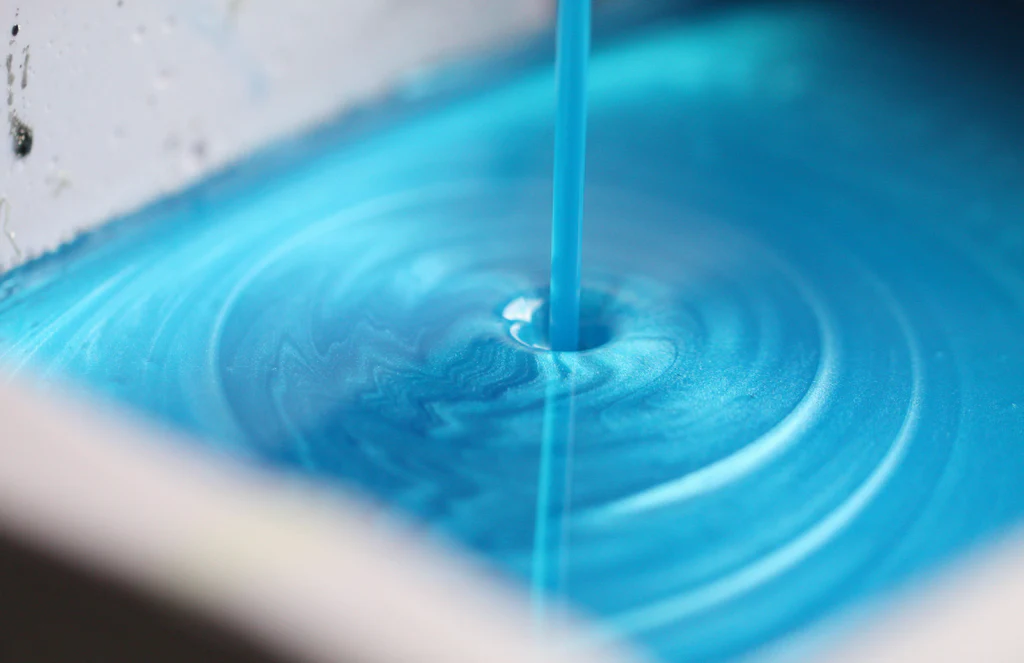Is Resin Toxic? [+Safety Precautions]

Learn about resin toxicity, its types, safety tips, and how to handle, store, and dispose of resin safely.
Introduction


If you’ve ever worked with resin—whether in 3D printing, crafts, or industrial applications—you might have wondered: Is Resin Toxic? The short answer is “Yes, resin can be toxic, especially in its liquid, uncured form”.
Depending on the type, resins can contain chemicals that irritate the skin, eyes, and lungs—and with repeated exposure, they may pose more serious health risks. But it’s not all bad news: once fully cured, many resins become much safer to handle.
In this article, we’ll break down what resin is, how it works, and why it can be harmful—so you can stay safe and informed.
How Resin Works
Resin usually starts as a liquid or gel, then transforms into a solid through a chemical reaction called curing. This process varies by resin type:
Epoxy and polyester resins: Cure when mixed with a hardener or catalyst.
UV resin: Cures under ultraviolet (UV) light.
Once cured, the resin becomes solid, durable, and often glossy.
Key Properties of Resin
Resin is popular in many industries due to these unique characteristics:
Adhesive – Bonds surfaces together extremely well.
Durable – Resists water, chemicals, and wear over time.
Moldable – Can be poured into molds and shaped before it hardens.
Decorative – Naturally glossy, and can be clear or colored, ideal for art and jewelry.
Types of Resin
In materials science and industrial applications, resin can be categorized into various types based on different classification standards.
Below is an explanation of common classification methods:
1. Classification by Curing Method (Reversible by heat/light or not)
Type | Description | Common Examples |
|---|---|---|
Thermosetting Resin | Irreversibly cures when heated or mixed with a hardener; cannot be remelted | Epoxy resin, phenolic resin, polyurethane resin, UV resin |
Thermoplastic Resin | Can be repeatedly melted and reshaped with heat; undergoes physical changes | PLA, ABS, PETG, TPU, Nylon |
2. Classification by Source of Composition
Type | Description | Examples |
|---|---|---|
Natural Resin | Organic materials extracted from plants, animals, or minerals | Rosin, amber, shellac |
Synthetic Resin | Man-made polymers with specific properties | Polyester resin, epoxy resin, acrylic resin |
3. Classification by Application/Use
Type | Description | Representative Materials |
|---|---|---|
Structural Resin | High strength, used in structural parts | Epoxy resin, phenolic resin, polyurethane |
Encapsulation Resin | Used for sealing electronics and protecting circuits | Epoxy potting resin, silicone resin |
3D Printing Resin | Designed for SLA/DLP/LCD technologies for high precision | Standard photopolymer, ABS-like resin, flexible resin |
Art/Craft Resin | For making models, jewelry, ornaments, figures | UV resin, transparent epoxy, colored resin |
Coating/Adhesive Resin | Used in industrial paints, adhesives | Acrylic resin, polyester resin, epoxy resin |
4. Classification by Chemical Structure
Type | Description | Examples |
|---|---|---|
Polyester Resin | Low cost, widely used in fiberglass and mold making | Unsaturated polyester resin |
Epoxy Resin | Strong adhesion, excellent insulation and corrosion resistance | Bisphenol-A type epoxy resin |
Acrylic Resin | Good film-forming ability, transparency, and weather resistance | PMMA, UV-curable acrylic resin |
Polyurethane Resin | High elasticity and abrasion resistance; used in coatings and elastomers | Elastic polyurethane, PU resin |
Phenolic Resin | High heat resistance, flame retardant; used in electronics and automotive | Phenolic molding compound, laminated sheets |
Why is Resin Toxic?
Resin is toxic mainly when it is uncured (in liquid form) because it contains harmful chemicals. Here's a breakdown:
1. Harmful Chemicals in Resin
Resin Type | Why It’s Toxic |
|---|---|
Epoxy Resin | Contains BPA and amine hardeners → cause skin irritation and long-term allergies |
Polyester Resin | Contains styrene → a strong-smelling vapor that can damage lungs and brain |
Polyurethane Resin | Releases isocyanates → highly toxic to lungs, may cause asthma |
UV Resin (Acrylic) | Contains acrylate monomers → irritate skin, eyes, and lungs before curing |
2. How Resin Affects the Body
Exposure Route | Effect |
|---|---|
Inhalation | Fumes can cause dizziness, headaches, or lung damage |
Skin Contact | May cause rashes, burns, or allergic reactions |
Eye Contact | Can result in serious irritation or injury |
Ingestion | Swallowing resin is dangerous and possibly fatal |
3. Toxicity Depends on Curing Stage
Stage | Toxicity Level | Why |
|---|---|---|
Uncured | ❗ Very Toxic | Contains active, volatile chemicals |
During Curing | ⚠ Still Harmful | Emits fumes (VOCs), may heat up |
Fully Cured | ✅ Generally Safe | Chemically stable, but dust from sanding is irritant |
Summary: Why Resin is Toxic
Reason | Explanation |
|---|---|
Volatile chemicals | Release harmful vapors like styrene or isocyanates |
Skin and eye irritants | Cause burns, rashes, or allergic reactions |
Sensitizers | Long-term exposure can lead to permanent allergies |
Respiratory risks | Fumes can inflame or damage lungs |
Toxic before curing | Liquid resins are the most dangerous |
Common Resin Types and Toxicity Comparison Table
Different resins have varying toxicity levels based on their chemical makeup and usage.
Here's a simplified comparison of common resin types, their hazards, and safety tips for handling.
Resin Type | Toxicity Level | Potential Hazards | Special Notes |
|---|---|---|---|
Epoxy Resin | Medium to High | - Skin and eye irritation | Safer after curing, but sanding dust can still be harmful |
Polyester Resin | High | - Contains styrene, inhalation may cause headaches, dizziness, and lung damage | Proper ventilation is critical; avoid prolonged contact with uncured materials |
Polyurethane Resin | Medium to High | - Releases isocyanates during curing, potent respiratory irritants | Especially hazardous in spraying or large-area applications; respiratory protection is required |
UV Resin / Acrylic Resin | Medium to High | - Skin and eye irritation | Toxic before curing; protective gear and ventilation are necessary during use |
Natural Resin (e.g., Rosin, Shellac) | Low to Non-Toxic | - May cause mild skin allergies in sensitive individuals | Generally safe; widely used in art and food-contact materials |
Safety Precautions
Safety is key when working with resins. To reduce risks, it's important to follow safety measures that protect both you and your workspace.
The following guidelines cover handling, storage, disposal, and what to do if exposed. By following these precautions, you can work more safely and minimize health and environmental risks.
1. Personal Protective Equipment (PPE)
Gloves: Use chemical-resistant nitrile gloves (avoid latex).
Eye Protection: Wear safety goggles or a face shield to guard against splashes.
Respirator: Use a NIOSH-certified respirator with organic vapor cartridges when ventilation is insufficient or when spraying high-VOC resins.
Protective Clothing: Wear long sleeves, a lab coat or apron, and closed-toe shoes to minimize skin contact.
2. Work in a Well-Ventilated Area
Use resin in open or well-ventilated environments.
For indoor use, install fume extractors, exhaust fans, or work under a chemical fume hood.
Avoid small, enclosed, or poorly ventilated areas.
3. Safe Handling
Avoid any direct skin contact with uncured resin and hardeners.
Do not eat, drink, or smoke while working with resin.
Wash hands thoroughly after use, even when gloves were worn.
4. Proper Storage
Keep resin in its original container with a tightly sealed lid.
Store away from heat, flames, and direct sunlight.
Keep in a cool, dry, and well-ventilated area, out of reach of children and pets.
5. Flammability Awareness
Polyester and polyurethane resins often contain flammable solvents like styrene.
Keep away from open flames or heat sources.
Always have a Class B fire extinguisher nearby (for flammable liquids/chemicals).
6. Spill Response
Absorb spills with inert materials like sand or cat litter; dispose of as hazardous waste.
Never pour resin down the drain or discard uncured resin in regular trash.
7. Waste Disposal
Cured resin is usually inert and may be disposed of with regular waste (check local regulations).
Uncured or leftover resin and hardeners must be taken to a hazardous waste disposal facility.
8. In Case of Exposure
Skin Contact: Wash immediately with soap and water. Do not use solvents.
Eye Contact: Rinse with clean water for at least 15 minutes and seek medical help.
Inhalation: Move to fresh air; seek medical attention if symptoms persist.
Ingestion: Do not induce vomiting; seek emergency medical assistance immediately.
Conclusion
Resin is widely used in art, industry, and manufacturing, but it can be harmful—especially before it’s cured. Some types, like epoxy and polyester, release toxic fumes and can irritate the skin, eyes, or lungs.
To use resin safely, know the risks, wear protective gear, and work in a well-ventilated space. With proper care, resin can be both useful and safe.

FAQs
Is resin toxic when dry?
Once resin is fully cured (dry), it is generally non-toxic and safe to handle. However, uncured resin can be harmful, so it's important to take proper safety precautions during the application process.
Is epoxy resin toxic? And is epoxy resin toxic when dry?
Yes, uncured epoxy resin is toxic. It can cause skin irritation, allergic reactions, and respiratory issues due to the chemicals it contains. Once fully cured, epoxy resin is generally considered non-toxic and inert. However, if not properly cured or if additives are present, it may still release harmful substances.
Is UV resin toxic?
Yes, uncured UV resin is toxic. It can irritate the skin, eyes, and lungs, and may cause allergic reactions. Proper protection and ventilation are essential when handling it.
Is 3D print resin toxic?
Yes, most 3D printing resins (such as SLA or DLP resins) are toxic when uncured. Direct contact or inhalation of fumes can be harmful, so personal protective equipment and good ventilation are necessary.
Is cured resin toxic?
Fully cured resin is usually non-toxic and stable, but it’s still best to avoid prolonged skin contact and not use it for food-related applications unless it’s specifically labeled food-safe.
Is resin toxic to wear?
Cured resin is typically safe to wear, but some people may have skin sensitivities or allergic reactions. It's best to ensure resin jewelry or accessories are fully cured before wearing them and avoid prolonged skin contact with uncured resin.
Can you sand resin?
Yes, you can sand resin once it has fully cured. Start with a coarse grit sandpaper to remove rough areas, and then use finer grit sandpaper for a smoother finish.
Can you paint resin?
Yes, you can paint resin. It's best to use a primer designed for plastic or resin before painting to ensure good adhesion. Acrylic paints are commonly used for resin surfaces.

